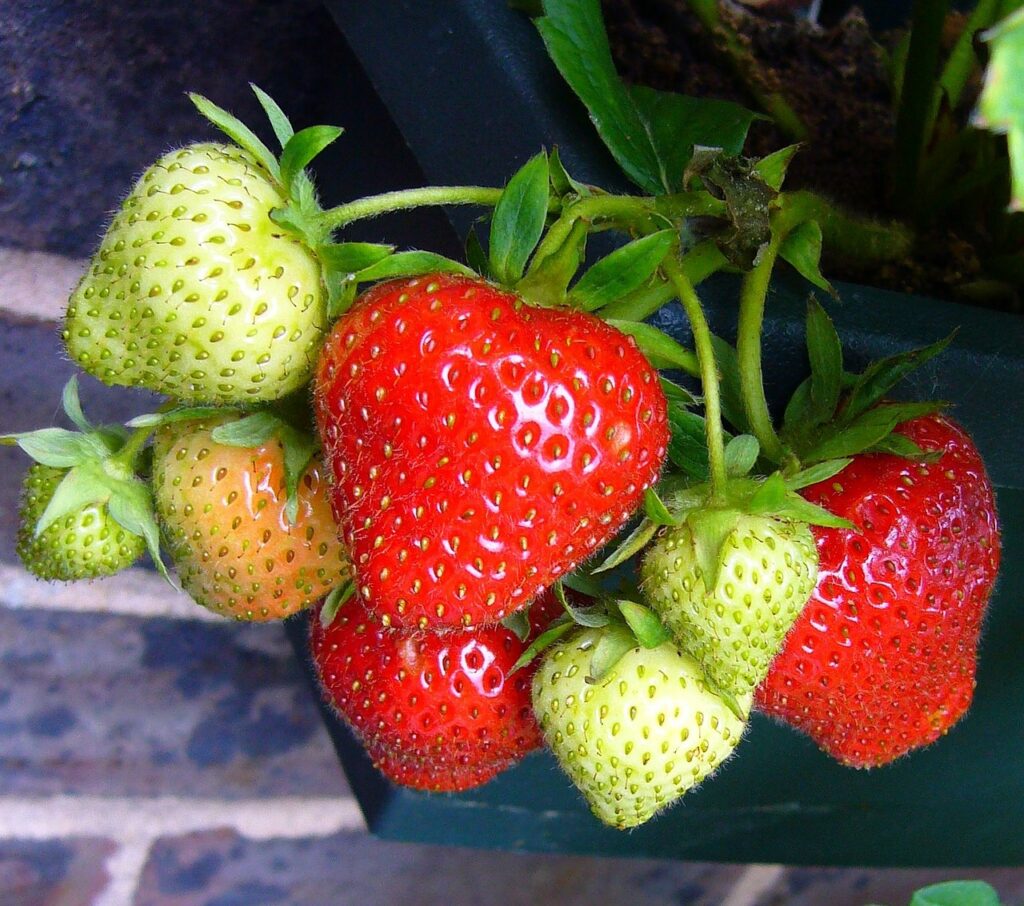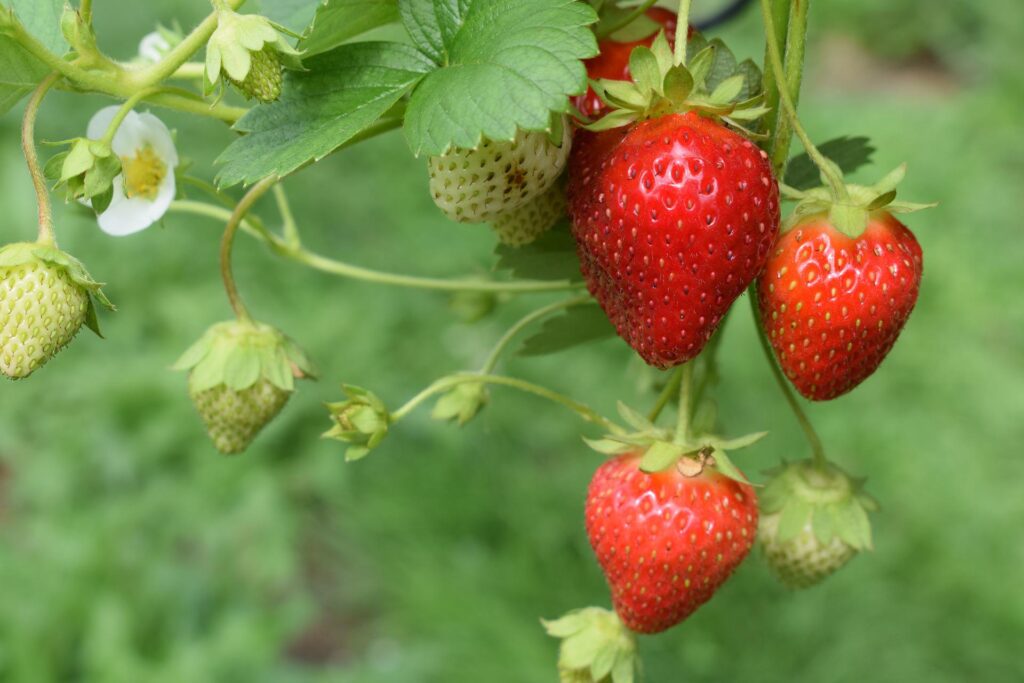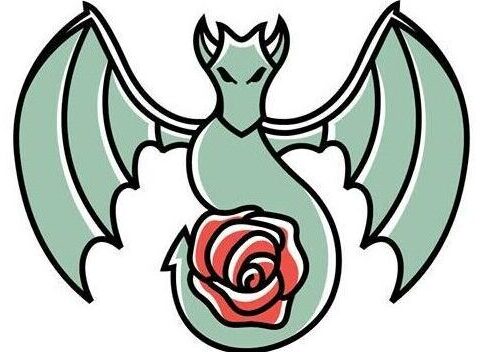(and a few of the worst companion plants as well)

A strawberry bed in June is the best thing in the world. You can smell the fragrance of the berries in the warm sun, and the sun-warmed berries taste so sweet. Mrs. Robin and Mrs. Catbird will be keeping an eye on the proceedings, because they want some berries too.
What if I told you that there’s a way to make your strawberries taste even better, give them a few extra nutrients, and keep insect pests at bay.
Strawberries need companion plants!
Companion planting is adding other plants around a strawberry patch to attract pollinators, deter pests, attract beneficial insects, and make strawberries grow better. Companion plants can help improve strawberry yields as well.
Here are the best – and worst – companion plants for strawberries
Why should you use companion plants for strawberries?
For a number of reasons! Companion plants improve pollination, create a healthy ecosystem, increase beneficial insects while decreasing garden pests. And it makes your garden prettier.
Improve pollination
A study published by the Royal Entomological Society in 2020 states that “companion plants were found to significantly increase both yield and market quality of strawberries” due to increased pollination of the flowers. These strawberry plants produced 35% more fruits, and the berries were larger and prettier.
How Pollination Works
Here’s why pollinators are so important to strawberries. Most flowers have one ovary where a single seed forms. A strawberry flower can have up to 500. On the full-grown fruit, these ovaries turn into the little strawberry seeds all over the fruit – biologists call them achemes.
Every one of those achemes need to be fully pollinated. Strawberry flowers can pollinate themselves, but pollinator insects do a much better job, getting up to 91% of the achemes pollinated.
When a group of achemes are not pollinated, you get a deformed berry with a cluster of little green seeds, usually at the bottom of the strawberry, and that doesn’t taste very good. Or, worse, all you get is a little green nubbin all covered with seeds. But when the strawberry is fully pollinated, you get a big ol’ happy red berry that looks gorgeous and tastes so sweet.
(Side note: Those achemes might contribute to the antioxidant compounds in the strawberry – even more reason to get these strawberries pollinated.)
Come On Over, Honeybees
Bringing pollinators into a garden, especially now when fewer pollinators live in the world (habitat loss, pesticide use, and climate change have triggered a decline in the numbers of bees and other pollinator insects) is so helpful to your strawberry patch, as well as your other garden plants.
If you plant a bank of flowering companion plants next to your strawberry patch, you’ll help attract pollinators to your yard and feed them – and they’ll busily pollinate your strawberries in return. Everybody wins!
(And the aforementioned study also states that a strip of flowers might increase pollinator visits by 25% — which is good news for your strawberries. And more flowers in our lives is always a good thing.)
Happy Ecosystem, Happy Plants
To find the best way to grow any plant in the garden, look at the conditions it grows best in in the wild.
Wild strawberries grow in open sunlight with just a little shade, and they can be found growing surrounded by other plants, leaf to leaf. Plants in the wild, in general, share their space with a hodgepodge of other plants. Nature hates a monoculture, and if you try to grow one plant over a large area, other plants grow up from the soil to share the space.
There are a number of ecological benefits to having a community of diverse plants all around you. The largest benefit is that a diverse ecology makes all of its members more resilient, making them more adept at fighting off pest insects and diseases.
Companion planting creates a diverse plant community in your garden, giving beneficial insects more places to live, more pollen and nectar for them to eat, and more hiding places to lie in wait for the insect pests they are ready to devour.
Fewer strawberry pests (and more beneficial insects)!
A number of insects, arthropods, and other invertebrates (including snails and slugs) will feed on strawberries. However, when you have companion plants around your strawberry patch, not only are you bringing in pollinators, but you’re also bringing in so many beneficial insects. Some of those beneficials will get to work taking out the insect pests and having them for lunch.

**11 Best Companion Plants for Strawberries**
Vegetables!
Garlic and onions – These plants are members of the Allioideae subfamily (which includes Alliums such as chives). When garlic is planted between rows of strawberries, it actually reduces the number of spider mites on strawberry plants by up to 52%.
Garlic also seems to repels pests such as cabbage aphids with its pungent order. Not only that, but populations of soil organisms such as bacteria and soil fungus increased when garlic was interplanted with other plants – and this increase of life in the soil is wonderfully helpful to the plants that live in it.
Garlic and onions are best planted in early spring. You can get “onion sets”, which are bundles of baby onions, at your local nurseries. They’re some of the first plants to go into the ground.
Spinach – This leafy vegetable is a friend to strawberry plants, and both plants help the others to grow. They will also help shade each other as the days get hotter.
Spinach is also an early spring plant. Sow the seeds in a warm, sunny location, and water as necessary to keep the soil from drying out.
Peas – Early peas, planted near the strawberry patch, boost soil quality by fixing nitrogen in the soil. The early peas will be finished about the time the strawberries bear fruit, so you can pull up the finished peas, but the soil-building qualities of its roots will remain.
Peas are sown through the early spring. Sow a row or partial row every week so the peas will have a longer harvest time.
Rhubarb – Rhubarb, the old classic strawberry friend, but also a good plant to have handy if you want to cut a few stems to make a nice strawberry rhubarb pie.
Rhubarb is a perennial plant, so it will come back year after year, just like your strawberries. Plant it on the north side of the patch so its broad leaves don’t shade out the plants. Eat only the stems – never the leaves.
Flowers!
Lupins – This flowering plant, also a member of the pea family, will fix nitrogen in the soil while attracting pollinators to your garden. The blossoms are gorgeous as well. These can be directly sown in the garden, or you can buy baby plants at the local nursery.
Sweet Alyssum – This popular annual with its fragrant white, purple, or pink flowers is a pollinator-friendly plant, and grows small enough so it won’t overpower the strawberry plants. Use these to edge the strawberry patch, as alyssum is a smaller plant that might be overwhelmed.
You can sow sweet alyssum in the garden, or you can go crazy at the local nursery and buy a bunch of them.
Marigolds – These bright orange or yellow flowers attract pollinators. These are also trap plants for root-knot nematodes. If you pull one up and find knotty little nodules on the roots, that means these pesky nematodes have taken up residence here. Then you pull up the rest of the marigolds, and the nematodes are out of your soil for good. Don’t compost the roots, though! Throw those away.
Herbs!
Chamomile – Grow these herbs in pots, because otherwise they will spread like crazy. But they bloom at the same time your strawberries are ripening, attracting both pollinators, hoverflies, and parasitic wasps that lay eggs inside insect pests. And you can gather the flower heads and make chamomile tea, just like Peter Rabbit’s mother did in the Beatrix Potter story.
Calendula – These cheerful yellow daisy-like flowers are great at attracting new pollinators, with the extra benefits of being handy any time you need some edible flowers to dress up your salad. These can be directly-sown into the garden after frost, or planted.
Borage – This pollinator-friendly plant with the sky-blue flowers attracts honeybees and bumblebees to your strawberries – but it also brings in a wider range of pollinators, including the hoverfly, aka syrphid fly or flower fly, a beneficial insect whose larvae will eat aphids and other insect pests like scale, mites, and thrips.
Chives – Warning: Chives will spread by seeds and by bulbs, so grow chives in a pot so you can keep them contained. Their strong smell will help keep pests at bay, just as the garlic and onions do.
**The 4 Worst Companion Plants for Strawberries!**
IMPORTANT NOTE: Do not plant strawberries in a soil where you’ve grown members of the nightshade family (tomatoes, potatoes, peppers, eggplants, okra), mint plants, chrysanthemums, roses in the past five year. The roots of these plants can leave diseases like verticillium wilt in the soil, which can affect your crops.
When buying your strawberry plants, choose disease-free strawberry plants that are resistant to Verticillium fungus. According to the Ohio State University Extension, resistant strawberry varieties include Allstar, Catskill, Delite, Earliglow, guardian, Lester, Rechief, Scott, Sunrise, Surecrop, and Tennessee Beauty. Everbearing varieties include Tribute and Tristar.
Brassicas – These members of the mustard family – including cabbage, broccoli, cauliflower, collard greens, Brussels sprouts, cabbage, and kale – steal nutrients from your strawberries so they bear smaller fruit, and we can’t have that.
Tomatoes – Tomato plants tend to get bigger than you expect, and they will crawl all over your strawberries if you let them. Tomato plants are bad companion plants because they can also pass verticillium wilt to your strawberries – a soil-borne fungal disease called that makes the plants shrivel up and turn brown.
Melons – The ultimate space hogs. They will take over your strawberry patch if you let them. They also get insect pests that might migrate into your strawberries, and can pass diseases to your plants.
Potatoes – Not only are those hills and underground tubers disruptive to your strawberry patch, but this member of the Nightshade family can also spread diseases to your strawberry plants.
